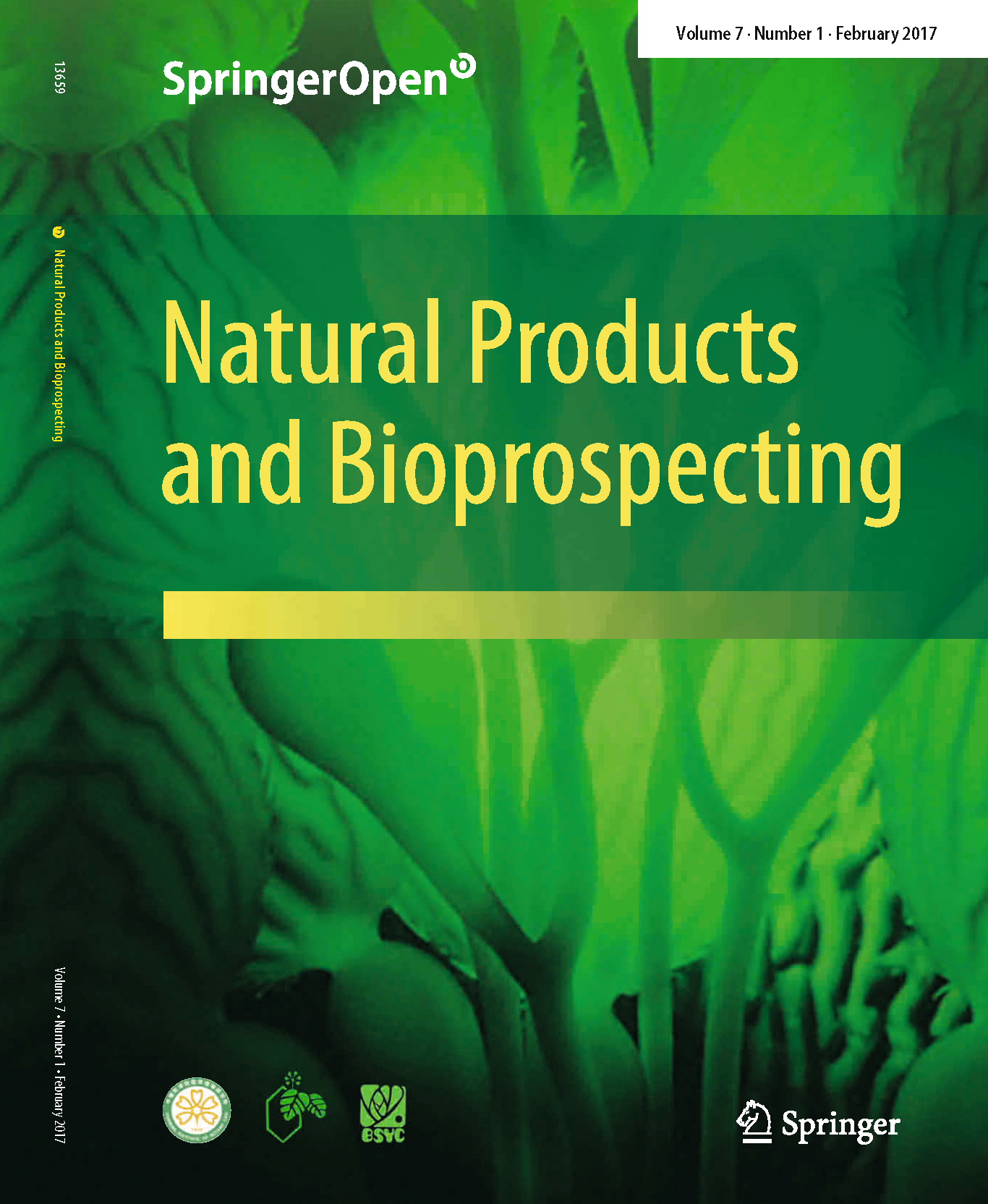|
|
Natural Products Diversity of Marine Ascidians (Tunicates; Ascidiacea) and Successful Drugs in Clinical Development
Collect
Satheesh Kumar Palanisamy, N. M. Rajendran, Angela Marino
Natural Products and Bioprospecting. 2017, 7 (1): 1-111.
DOI: 10.1007/s13659-016-0115-5
This present study reviewed the chemical diversity of marine ascidians and their pharmacological applications, challenges and recent developments in marine drug discovery reported during 1994-2014, highlighting the structural activity of compounds produced by these specimens. Till date only 5% of living ascidian species were studied from <3000 species, this study represented from family didemnidae (32%), polyclinidae (22%), styelidae and polycitoridae (11-12%) exhibiting the highest number of promising MNPs. Close to 580 compound structures are here discussed in terms of their occurrence, structural type and reported biological activity. Anti-cancer drugs are the main area of interest in the screening of MNPs from ascidians (64%), followed by anti-malarial (6%) and remaining others. FDA approved ascidian compounds mechanism of action along with other compounds status of clinical trials (phase 1 to phase 3) are discussed here in. This review highlights recent developments in the area of natural products chemistry and biotechnological approaches are emphasized.
References |
Related Articles |
Metrics
|
|
|
Quebrachitol: Global Status and Basic Research
Collect
Dong Wang, Shu-Qun Zhang, Zhe Chang, De-Xin Kong, Zhi-Li Zuo
Natural Products and Bioprospecting. 2017, 7 (1): 113-122.
DOI: 10.1007/s13659-017-0120-3
Recently, there has been a renewed interest in the natural-products-inspired drugs. Quebrachitol (QCT) is one of naturally occurring optically active cyclitols that has now received considerable attention. Until the last decade, it came to be a starting point for the lead discovery. In this review, we had a discussion on the basic research of QCT, including its source, structure, properties, and the recent advances on its application. The biological activities and QCT-inspired leads that are potentially effective for treating human diseases were also discussed.
References |
Related Articles |
Metrics
|
|
|
Seco-sativene and Seco-longifolene Sesquiterpenoids from Cultures of Endophytic Fungus Bipolaris eleusines
Collect
Man-Si Yang, Xiao-Yue Cai, Yuan-Yuan He, Meng-Ying Lu, Shuang Liu, Wen-Xiang Wang, Zheng-Hui Li, Hong-Lian Ai, Tao Feng
Natural Products and Bioprospecting. 2017, 7 (1): 147-150.
DOI: 10.1007/s13659-016-0116-4
Two new seco-sativene sesquiterpenoids, bipolenins D (1) and E (2), a new seco-longifolene sesquiterpenoid, bipolenin F (3), together with three known analogues (4-6), were obtained from cultures of endophytic fungus Bipolaris eleusines. Their structures were established by MS and NMR data. Compounds 1-6 showed no activity to five human cancer cell lines.
References |
Related Articles |
Metrics
|
|
|
Pharmacological and Predicted Activities of Natural Azo Compounds
Collect
Valery M. Dembitsky, Tatyana A. Gloriozova, Vladimir V. Poroikov
Natural Products and Bioprospecting. 2017, 7 (1): 151-169.
DOI: 10.1007/s13659-016-0117-3
This paper describes research on natural azo compounds isolated from fungi, plant, bacteria, and invertebrates. More than 120 biologically active diazene containing alkaloids demonstrate confirmed pharmacological activity, including antitumor, antimicrobial, and antibacterial effects. The structures, origin, and biological activities of azo compounds are reviewed. Utilizing the computer program PASS, some structure-activity relationship new activities are also predicted, pointing toward possible new applications of these compounds. This article emphasizes the role of natural azo compounds as an important source of drug prototypes and leads for drug discovery.
References |
Related Articles |
Metrics
|
|
|
Enantioselective Resolution of (R, S)-Carvedilol to (S)-(-)-Carvedilol by Biocatalysts
Collect
Swetha Ettireddy, Vijitha Chandupatla, Ciddi Veeresham
Natural Products and Bioprospecting. 2017, 7 (1): 171-179.
DOI: 10.1007/s13659-016-0118-2
Among the microorganisms employed in the study, Aspergillus niger (GUFCC5443), Escherichia coli (ATCC9637), Streptomyces halstedii (CKM-2), Pseudomonas putida (NCIB9494), Cunninghamella elegans (NCIM689) and Sphingomonas paucimobilis (NCTC11030) were capable for the enantioselective conversion of racemic Carvedilol. Immobilization technique enhanced the enantioselectivity of microorganisms and thus increased the enantiomeric purity of the drug. Excellent enantiomeric ratios (E) were found in reactions catalyzed by immobilized A. niger and E. coli with values 174.44 and 104.26, respectively. Triacylglycerol lipase from Aspergillus niger was also employed in this study as a biocatalyst which resulted in the product with 83.35% enantiomeric excess (ee) and E of 11.34 while the enzyme on immobilization has yielded 99.08% ee and 216.39 E. The conversion yield (C%) of the drug by free-enzyme was 57.42%, which was enhanced by immobilization to 90.51%. Hence, our results suggest that immobilized triacylglycerol lipase from A. niger (Lipase AP6) could be an efficient biocatalyst for the enantioselective resolution of racemic Carvedilol to (S)-(-)- Carvedilol with high enantiomeric purity followed by immobilized cultures of A. niger and E. coli.
References |
Related Articles |
Metrics
|
|

